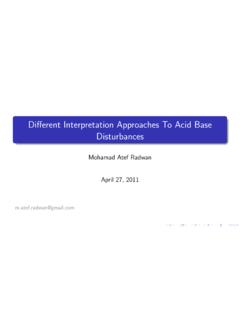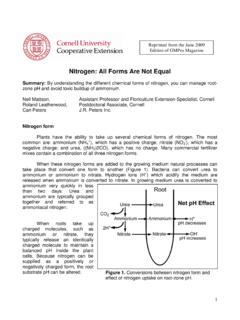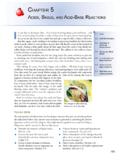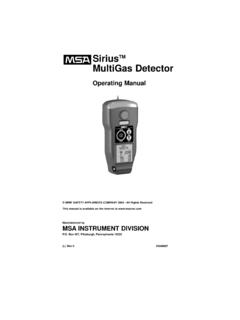Transcription of Computational Study on the Solubility of Lithium …
1 Computational Study on the Solubility of Lithium Salts Formed on Lithium Ion BatteryNegative Electrode in Organic SolventsKen Tasaki*, and Stephen J. Harris Mitsubishi Chemical USA, 410 Palos Verdes BouleVard, Redondo Beach, California 90277, and GeneralMotors Corporation Research & DeVelopment Center, Mail Code 480-102-000, 30500 Mound Road,Warren, Michigan 48090 ReceiVed: January 2, 2010; ReVised Manuscript ReceiVed: March 22, 2010 The Solubility of Lithium salts, found in solid-electrolyte interface (SEI) films on the anode surface in lithiumion battery cells, has been examined in organic solvents through atomistic computer simulations. The saltsincluded Lithium oxide (Li2O), Lithium carbonate (Li2CO3), Lithium oxalate ([LiCO2]2), Lithium fluoride (LiF), Lithium hydroxide (LiOH), Lithium methoxide (LiOCH3), Lithium methyl carbonate (LiOCO2CH3), lithiumethyl carbonate (LiOCO2C2H5), and dilithium ethylene glycol dicarbonate (([CH2 OCO2Li]2: LiEDC).)
2 Theorganic solvents were dimethyl carbonate (DMC) and ethylene carbonate (EC). The atomic charges in theforce field have been fitted to the electrostatic potential obtained from density functional theory calculationsfor each salt. The heat of dissolution in DMC for the salts calculated from computer simulations ranged fromexothermic heats for the organic salts in general to endothermic heats for the inorganic salts in the order ofLiEDC<LiOCO2CH3<LiOH<LiOCO2C2H5<LiOCH3 <LiF<[LiCO2]2<Li2CO3<Li2O where thevalue of the heat went from more negative in the left to more positive in the right. In EC, the order was moreor less the same, but the salts were found to dissolve more than DMC in general. The analysis from simulationswas performed to rationalize the Solubility of each salt in DMC and also the Solubility difference between inDMC and EC.
3 The latter was found to be due not only to the difference in polarity between the two solvents,but we also suspect that it may be due to the molecular shapes of the solvents. We also found that theconformation of LiEDC changed in going from DMC to EC, which contributed to the difference in solid-electrolyte-interface (SEI) film formed on thenegative electrode in Lithium ion battery cells has been foundto be a key component affecting important cell performanceparameters, such as cycle life, calendar life, irreversible capacityloss, safety, and dissolution of the SEI filmduring cycling or storage has been discussed by a number ofgroups and has been claimed to be a major cause for ,34,35 Film dissolution can result in exposure of theelectrode surface to the electrolyte, prompting irreversiblereactions with the electrolyte, thus reducing the cell , most of the previous reports have been based onindirect observations of the film dissolution, such as thedisappearance of differential scanning calorimetry peaks5andchanges in the X-ray photospectroscopy spectra13,21,26,34.
4 35or theatomic force microscopy images13before and after cycling orstorage. We have recently determined the Solubility of individuallithium salts typically found in the SEI film in dimethylcarbonate (DMC) through ion conductivity that organic salts were more likely to dissolve thaninorganic salts. On the basis of the results, we proposed amechanism by which a capacity fading may be facilitated bythe SEI film dissolution, but we provided little interpretationof the Solubility data in our previous simulation may be a useful tool to interpret theexperimental Solubility data and gain insight into the solubilitybehavior of the Lithium salts in organic solvents. Further,rationalization of the Lithium salt Solubility measurements mayprovide useful information for designing a stable SEI film.
5 Wereport here a detailed examination of the Solubility of the lithiumsalts using the results from computer simulations. The lithiumsalts studied here include Lithium oxide (Li2O), Lithium carbonate(Li2CO3), Lithium oxalate ([LiCO2]2), Lithium fluoride (LiF), Lithium hydroxide (LiOH), Lithium methoxide (LiOCH3), lithiummethyl carbonate (LiOCO2CH3), Lithium ethyl carbonate(LiOCO2C2H5), and dilithium ethylene glycol dicarbonate([CH2 OCO2Li]2, LiEDC), all of which have been found as SEIfilm ,5,9,14-35 The solvents in which the solubilityof the Lithium salts was examined were DMC and ethylenecarbonate (EC). This work is a series of reports in understandingSEI film Solubility , which may lead to practical rejuvenationof Lithium ion cells. Because the application of Lithium ionbatteries for transportation is expected to grow, recycling orrefurbishing used cells will become an important Lithium salts studied here may fall into a category ofionic solids in materials science.
6 Computer modeling of ionicsolids has been found to be challenging due to the strongpolarization effects, among other , computationalmodeling approaches have been successfully applied to severallithium ions, such as Li2O38-46and primary reasonfor such a predominantly large number of reports for Li2 Oisdue to its interest as an ionic , most ofthe studies used ad hoc force fields for particular , very few potential functions or force field param-eters have been proposed for the other Lithium salts examinedin this Study , partially due to the lack of experimental data. We* Corresponding author. E-mail: Mitsubishi Chemical USA. General Motors Phys. Chem. C2010,114,8076 2010 American Chemical SocietyPublished on Web 04/06/2010have recently reported Solubility data for a variety of provides an opportunity to test and optimize ourforce field parameters against the experimental data.
7 In thisstudy, we attempt to treat a wide range of salts, includinginorganic and organic salts, with either monolithium ion ordilithium ions within the framework of a single potentialfunction. Very few (theoretical) Solubility studies have beenreported for such a diverse range of salts in organic model ionic solids with reasonable accuracy, it is oftendesirable to include polarizable potential functions in the forcefield. However, parametrization of such functions can be time-consuming and requires special expertise. On the other hand,commercial software packages are broadly available and ac-cessible. Materials Studio is a widely used commercial packageavailable from Accelrys, Inc. We will examine the effectivenessof a commercial package dealing with the Solubility of ionicsolids in this 1 shows the chemical structures of all the moleculesinvolved in the calculations.
8 Figure 2 illustrates the thermody-namic cycle used in the calculations of the heat of dissolutionfor each salt in DMC and EC. The heat of sublimation ( Hsub),the heat of solution ( Hsol), and the heat of dissolution ( Hdiss)were obtained from the following equations:where Esubis the energy required to bring the salt moleculefrom the condensed phase to the gas phase, and Esolis theenergy required to transfer the same salt molecule from the gasphase to the organic ,49 Both Esuband Esolwereobtained from the MD the gas constantand the absolute temperature, respectively. The temperature was298 K. The volume change between the salt solution and theliquid (DMC or EC) in the calculation of the heat of solutionwas assumed to be software package, Materials Studio, used for this studyis commercially available from Accelrys, force field,using a pairwise potential function, was COMPASS51includingautomatic parameters52except for the atomic charges.
9 Theatomic charges have been derived from density functional theory(DFT) calculations using the Perdew-Burke-Ernzerhof (PBE)exchange-correlation functional53,54through electrostatic poten-tial fitting. The basis set was the double-numerical polarizationbasis set including one atomic orbital (AO) for each occupiedatomic orbital, the second set of valence AOs,d-functions fornon-hydrogen atoms, andp-functions on hydrogen charges thus derived for each salt and solvent are shownFigure chemical structures of all molecules studied: (a) Lithium fluoride, (b) Lithium oxide, (c) Lithium hydroxide, (d) Lithium methoxide,(e) Lithium carbonate, (f) Lithium methyl carbonate, (g) Lithium ethyl carbonate, (h) dilithium ethylene glycol dicarbonate, (i) Lithium oxalate,(j)dimethyl carbonate, and (k) ethylene carbonate.
10 The structures displayed were taken from the optimized structures by energy minimization by DFTcalculations. The atomic charges, not shown for the hydrogen atoms, used in computer simulations are also shown by or on the thermodynamic cycle used for the calculations of theheat of sublimation ( Hsub), the heat of solution ( Hsol), and the heatof dissolution ( Hdiss). Hsub) Esub+RT(1) Hsol) Esol-RT(2) Hdiss) Hsub+ Hsol(3) Solubility of Li SaltsJ. Phys. Chem. C, Vol. 114, No. 17, 20108077in Figure 1. The van der Waals parameters in COMPASS including automatic parameters are proprietary to Accelrys, could not be changed for this Study ; thus, the originalparameters were used. For each salt, 1 ns simulations were runat 298 K under theNPTensemble, under which the number ofatoms, the pressure, and the temperature were constant duringthe simulation, for a cell having a side length of 20.









